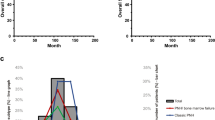Abstract
We report a patient with aplastic anemia (AA)—paroxysmal nocturnal hemoglobinuria (PNH) syndrome who developed acute myelogenous leukemia (AML). Flow cytometric analysis showed that the leukemic cells in the bone marrow lacked CD59 antigen on their surface and were positive for P-glycoprotein. Heteroduplex and single-strand conformation polymorphism analysis followed by sequencing of the leukemic cells in the bone marrow disclosed 1 frameshift-type mutation in exon 2 of the phosphatidylinositol glycan-class A (PIG-A) gene, which deductively produces truncated PIG-A protein. These findings provide direct evidence that the leukemic cells evolved from the affected PNH clone. Cytogenetic analysis in the bone marrow in each stage of AA-PNH, AML, and at relapse of AML showed normal, −7, and −7 plus −20, respectively, showing evidence of a clonal evolution. Because complete remission of AML was not achieved by intensive chemotherapies, allogeneic peripheral blood stem cell transplantation (PBSCT) from the patient’s HLA-matched sister was performed successfully with recovery of CD59 antigen on bone marrow hematopoietic cells; however, leukemia relapsed 4 months after PBSCT. Leukemia derived from PNH may be resistant to intensive chemotherapy, and a highly myeloablative regimen may be required for stem cell transplantation to eradicate the PNH-derived leukemia clone.
Similar content being viewed by others
References
Takeda J, Miyata T, Kawagoe K, et al. Deficiency of the GPI anchor caused by a somatic mutation of the PIG-A gene in paroxysmal nocturnal hemoglobinuria.Cell. 1993;73:703–711.
Kinoshita T, Inoue N, Takeda J. Defective glycosyl phosphatidylinositol anchor synthesis and paroxysmal nocturnal hemoglobinuria.Adv Immunol. 1995;60:57–103.
Nishimura J, Murakami Y, Kinoshita T. Paroxysmal nocturnal hemoglobinuria: an acquired genetic disease.Am J Hematol. 1999;62:175–182.
Azenishi Y, Ueda E, Machii T, et al. CD59-deficient blood cells and PIG-A gene abnormalities in Japanese patients with aplastic anaemia.Br J Haematol. 1999;104:523–529.
Harris JW, Koscick R, Lazarus HM, Eshleman JR, Medof ME. Leukemia arising out of paroxysmal nocturnal hemoglobinuria.Leuk Lymphoma. 1999;32:401–426.
Devine DV, Gluck WL, Rosse WF, Weinberg JB. Acute myeloblastic leukemia in paroxysmal nocturnal hemoglobinuria: evidence of evolution from the abnormal paroxysmal nocturnal hemoglobinuria clone.J Clin Invest. 1987;79:314–317.
Nakahata J, Takahashi M, Fuse I, et al. Paroxysmal nocturnal hemoglobinuria with myelofibrosis: progression to acute myeloblastic leukemia.Leuk Lymphoma. 1993;12:137–142.
Shichishima T, Terasawa T, Hashimoto C, et al. Discordant and heterogeneous expression of GPI-anchored membrane proteins on leukemic cells in a patient with paroxysmal nocturnal hemoglobinuria.Blood. 1993;81:1855–1862.
van Kamp H, Smit J, van den Berg E, Ruud Halie M, Vellenga E. Myelodysplasia following paroxysmal nocturnal hemoglobinuria: evidence for the emergence of a separate clone.Br J Haematol. 1994;87:399–400.
Jin JY, Tooze JA, Marsh JCW, Matthey F, Gordon-Smith EC. Myelodysplasia following aplastic anaemia-paroxysmal nocturnal haemoglobinuria syndrome after treatment with immunosuppression and G-CSF: evidence for the emergence of a separate clone.Br J Haematol. 1996;94:510–512.
Mortazavi Y, Tooze J, Gordon-Smith E, Rutherford T. N-RAS gene mutation in patients with aplastic anemia/paroxysmal nocturnal hemoglobinuria during evolution to clonal disease.Blood. 1999;95:646–650.
Imamura N, Kusunoki Y, Kawa-Ha K, et al. Aggressive natural killer cell leukemia/lymphoma: report of four cases and review of the literature: possible existence of a new clinical entity originating from the third lineage of lymphoid cells.Br J Haematol. 1990;75:49–59.
Imamura N, Kimura A. Neutropenia among survivors of atomic bomb explosion.Lancet. 2000;355:117.
Imamura N, Tanaka R, Kajihara H, Kuramoto A. Analysis of peroxidase-negative acute unclassifiable leukemias by monoclonal antibodies, I: acute myelogenous leukemia and acute myelomonocytic leukemia.Eur J Haematol. 1988;41:420–428.
Nishimura J, Inoue N, Wada H, et al. A patient with paroxysmal nocturnal hemoglobinuria bearing four independent PIG-A mutant clones.Blood. 1997;89:3470–3476.
Stafford HA, Nagarajan S, Weinberg JB, Medof ME. PIG-A, DAF and proto-oncogene expression in paroxysmal nocturnal haemoglobinuria-associated acute myelogenous leukaemia blasts.Br J Haematol. 1995;89:72–78.
Nafa K, Bessler M, Deeg H, Luzzatto L. New somatic mutation in the PIG-A gene emerges at relapse of paroxysmal nocturnal hemoglobinuria.Blood. 1998;92:3422–3427.
Imashuku S, Hibi S, Kataoka-Morimoto Y, et al. Myelodysplasia and acute myeloid leukaemia in case of aplastic anaemia and congenital neutropenia following G-CSF administration.Br J Haematol. 1995;89:188–190.
Szer J, Deeg H, Witherspoon R, et al. Long-term survival after transplantation for paroxysmal nocturnal hemoglobinuria with aplastic anemia.Ann Intern Med. 1984;101:193–195.
Antin J, Ginsberg D, Smith B, Nathan D, Orkin S, Rapperport J. Bone marrow transplantation for paroxysmal nocturnal hemoglobinuria: eradication of the PNH clone and documentation of complete lymphohematopoietic engraftment.Blood. 1985;66:1247–1250.
Kolb H, Holler E, Bender-Gotze C, Walther U. Myeloablative conditioning for marrow transplantation in myelodysplastic syndromes and paroxysmal nocturnal haemoglobinuria.Bone Marrow Transplant. 1989;4:29–34.
Bemba M, Guardiola P, Garderet L, et al. Bone marrow transplantation for paroxysmal nocturnal haemoglobinuria.Br J Haematol. 1999;105:366–368.
Kawahara K, Witherspoon RP, Storb R. Marrow transplantation for paroxysmal nocturnal hemoglobinuria.Am J Hematol. 1992;39: 283–288.
Raiola A, Van Lint M, Lamparelli T, et al. Bone marrow transplantation for paroxysmal nocturnal hemoglobinuria.Haematologica. 2000;85:59–62.
Saso R, Marsh J, Cevreska L, et al. Bone marrow transplants for paroxysmal nocturnal haemoglobinuria.Br J Haematol. 1999;104: 392–396.
Cornelis F, Montfort L, Osselaer J, et al. Acute leukemia in paroxysmal nocturnal haemoglobinuria: case report and review of the literature.Hematol Cell Ther. 1996;1996:285–288.
Author information
Authors and Affiliations
Corresponding author
About this article
Cite this article
Tanaka, H., Imamura, N., Oguma, N. et al. Acute Myelogenous Leukemia WithPIG-A Gene Mutation Evolved from Aplastic Anemia—Paroxysmal Nocturnal Hemoglobinuria Syndrome. Int J Hematol 73, 206–212 (2001). https://doi.org/10.1007/BF02981939
Received:
Revised:
Accepted:
Published:
Issue Date:
DOI: https://doi.org/10.1007/BF02981939




